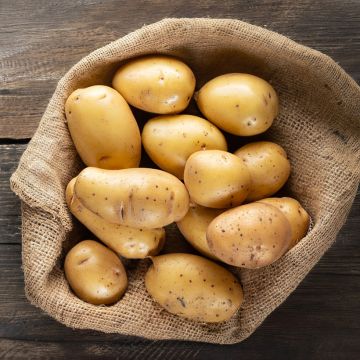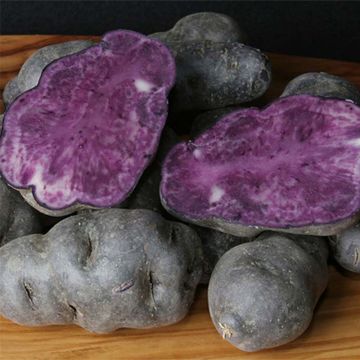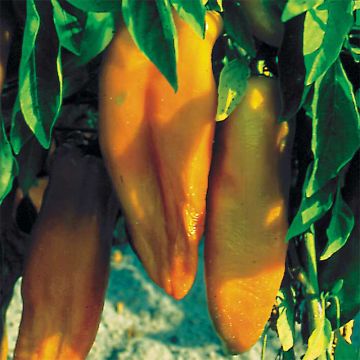

Smallanthus sonchifolius Red Yacon - Poire de terre


Smallanthus sonchifolius Red Yacon - Poire de terre
Smallanthus sonchifolius Red Yacon - Earth Pear
Smallanthus sonchifolius Red
Yacón, Peruvian ground apple
This item cannot be shipped to the selected country
Delivery charge from 6,90 €
More information
Shipping country:
-
-
-
-
-
-
-
-
-
-
-
-
-
-
-
-
-
-
-
-
-
-
-
-
-
-
-
-
-
-
-
-
Schedule delivery date,
and select date in basket
This plant carries a 6 months recovery warranty
More information
We guarantee the quality of our plants for a full growing cycle, and will replace at our expense any plant that fails to recover under normal climatic and planting conditions.
From 7,90 € for pickup delivery and 6,90 € for home delivery
Express home delivery from 8,90 €.
Description
The Earth Apple or Yacon, in Latin Smallanthus sonchifolius, is a root vegetable, very ancient, consumed in Peru for centuries, hence its common name of "Inca Root". This tuberous perennial, with a hardiness not exceeding -5°C (23°F), is cultivated as an annual and requires the bulbs to be dug up before winter. Red Yacon produces numerous tubers weighing 300 to 400 grams, with elongated shape and red skin. This fleshy vegetable, with its granular texture and white flesh, resembles that of a pear. Rich in water, the Incas used it as a refreshing juice. The sweet-tasting roots contain a very low-calorie natural sweetener. In the vegetable garden, in a warm and sunny location, red Yacon is grown in good garden soil, which is rich and light. Regular watering is necessary during the summer. This can be limited by mulching around the plants. The young Yacon plants are ideally planted from mid-May to mid-June, and the harvest takes place when the tubers are fully ripe from October to November, before the heavy frosts.
The earth apple belongs to the Asteraceae family, like Dahlias which have similar roots. This tuberous perennial plant, native to South America, is frost-sensitive and is grown as an annual in our climates. During the summer, the earth apple produces yellow flowers in heads, similar to sunflowers but smaller. They are borne at the top of hairy stems above a foliage composed of large triangular leaves. In the vegetable garden, allow for ample space, as Yacon can reach a height and width of 1.50 m (5ft)! This vigorous growth also means that the earth apple will shade neighboring plants.
In terms of cooking, Yacon, with its subtly sweet flavor and granular texture similar to a pear, can be eaten raw or cooked, in both savory and sweet dishes. Raw, it adds crunchiness to raw vegetable salads or fruit salads. If you want to cook it, it can be prepared like potatoes: boiled, steamed, sautéed, roasted in the oven, etc. In desserts, it pairs particularly well with chocolate. Like Jerusalem artichokes, it is rich in insulin and low in calories. Additionally, the leaves can be stuffed like cabbage leaves or dried for infusion (Yacon tea).
Harvesting: Yacon is a short-day plant. Tuber formation generally begins in September-October, when the foliage turns yellow. To allow for complete maturation, it is necessary to leave the tubers in the ground. In November, they are harvested when the leaves wilt after the first frost. Carefully, using a fork or a spade, dig up the entire stump and harvest the tubers. Let them dry for a few hours on the ground in dry weather.
Storage: The earth apple stores very well for several months. Store the tubers, like potatoes, in a cool and dry place, protected from light, in dry sand. The earth apples become slightly sweeter over time. Store the rest of the stump in the same conditions if you want to multiply it by division in the following spring.
Gardener's tip: Although the plant provides ground cover, we recommend mulching the soil to keep it moist and reduce weed growth, especially at the beginning of cultivation. This can be done with thin successive layers of grass clippings, preferably mixed with dead leaves.
Report an error about the product description
Smallanthus sonchifolius Red Yacon - Earth Pear in pictures




Harvest
Plant habit
Foliage
Other Traditional, unusual, exotic vegetable tubers
Planting and care
Planting of the ground pear should be done from mid-May, when the risk of frost has passed. The Ground Pear prefers deep, rich, and moist soil. Choose a sunny location. Add well-rotted compost in the previous autumn, after loosening the soil.
The Ground Pear will grow in size during its growth. Therefore, the young plants should be spaced 1.50m (5ft) apart in all directions. Dig a hole (3 times the volume of the root ball), place the root ball, and cover with fine soil. Firmly press down and water to keep the soil moist.
At the beginning of cultivation, lightly mound the base of the plants.
The Ground Pear can be propagated by division in spring. Cut the stump into several pieces, with each piece retaining at least one bud. Plant them in buckets and then transplant them into the ground when the soil has warmed sufficiently.
Cultivation
Care
Intended location
This item has not been reviewed yet - be the first to leave a review about it.
Old and forgotten vegetables
Haven't found what you were looking for?
Hardiness is the lowest winter temperature a plant can endure without suffering serious damage or even dying. However, hardiness is affected by location (a sheltered area, such as a patio), protection (winter cover) and soil type (hardiness is improved by well-drained soil).

Photo Sharing Terms & Conditions
In order to encourage gardeners to interact and share their experiences, Promesse de fleurs offers various media enabling content to be uploaded onto its Site - in particular via the ‘Photo sharing’ module.
The User agrees to refrain from:
- Posting any content that is illegal, prejudicial, insulting, racist, inciteful to hatred, revisionist, contrary to public decency, that infringes on privacy or on the privacy rights of third parties, in particular the publicity rights of persons and goods, intellectual property rights, or the right to privacy.
- Submitting content on behalf of a third party;
- Impersonate the identity of a third party and/or publish any personal information about a third party;
In general, the User undertakes to refrain from any unethical behaviour.
All Content (in particular text, comments, files, images, photos, videos, creative works, etc.), which may be subject to property or intellectual property rights, image or other private rights, shall remain the property of the User, subject to the limited rights granted by the terms of the licence granted by Promesse de fleurs as stated below. Users are at liberty to publish or not to publish such Content on the Site, notably via the ‘Photo Sharing’ facility, and accept that this Content shall be made public and freely accessible, notably on the Internet.
Users further acknowledge, undertake to have ,and guarantee that they hold all necessary rights and permissions to publish such material on the Site, in particular with regard to the legislation in force pertaining to any privacy, property, intellectual property, image, or contractual rights, or rights of any other nature. By publishing such Content on the Site, Users acknowledge accepting full liability as publishers of the Content within the meaning of the law, and grant Promesse de fleurs, free of charge, an inclusive, worldwide licence for the said Content for the entire duration of its publication, including all reproduction, representation, up/downloading, displaying, performing, transmission, and storage rights.
Users also grant permission for their name to be linked to the Content and accept that this link may not always be made available.
By engaging in posting material, Users consent to their Content becoming automatically accessible on the Internet, in particular on other sites and/or blogs and/or web pages of the Promesse de fleurs site, including in particular social pages and the Promesse de fleurs catalogue.
Users may secure the removal of entrusted content free of charge by issuing a simple request via our contact form.
The flowering period indicated on our website applies to countries and regions located in USDA zone 8 (France, the United Kingdom, Ireland, the Netherlands, etc.)
It will vary according to where you live:
- In zones 9 to 10 (Italy, Spain, Greece, etc.), flowering will occur about 2 to 4 weeks earlier.
- In zones 6 to 7 (Germany, Poland, Slovenia, and lower mountainous regions), flowering will be delayed by 2 to 3 weeks.
- In zone 5 (Central Europe, Scandinavia), blooming will be delayed by 3 to 5 weeks.
In temperate climates, pruning of spring-flowering shrubs (forsythia, spireas, etc.) should be done just after flowering.
Pruning of summer-flowering shrubs (Indian Lilac, Perovskia, etc.) can be done in winter or spring.
In cold regions as well as with frost-sensitive plants, avoid pruning too early when severe frosts may still occur.
The planting period indicated on our website applies to countries and regions located in USDA zone 8 (France, United Kingdom, Ireland, Netherlands).
It will vary according to where you live:
- In Mediterranean zones (Marseille, Madrid, Milan, etc.), autumn and winter are the best planting periods.
- In continental zones (Strasbourg, Munich, Vienna, etc.), delay planting by 2 to 3 weeks in spring and bring it forward by 2 to 4 weeks in autumn.
- In mountainous regions (the Alps, Pyrenees, Carpathians, etc.), it is best to plant in late spring (May-June) or late summer (August-September).
The harvesting period indicated on our website applies to countries and regions in USDA zone 8 (France, England, Ireland, the Netherlands).
In colder areas (Scandinavia, Poland, Austria...) fruit and vegetable harvests are likely to be delayed by 3-4 weeks.
In warmer areas (Italy, Spain, Greece, etc.), harvesting will probably take place earlier, depending on weather conditions.
The sowing periods indicated on our website apply to countries and regions within USDA Zone 8 (France, UK, Ireland, Netherlands).
In colder areas (Scandinavia, Poland, Austria...), delay any outdoor sowing by 3-4 weeks, or sow under glass.
In warmer climes (Italy, Spain, Greece, etc.), bring outdoor sowing forward by a few weeks.























































